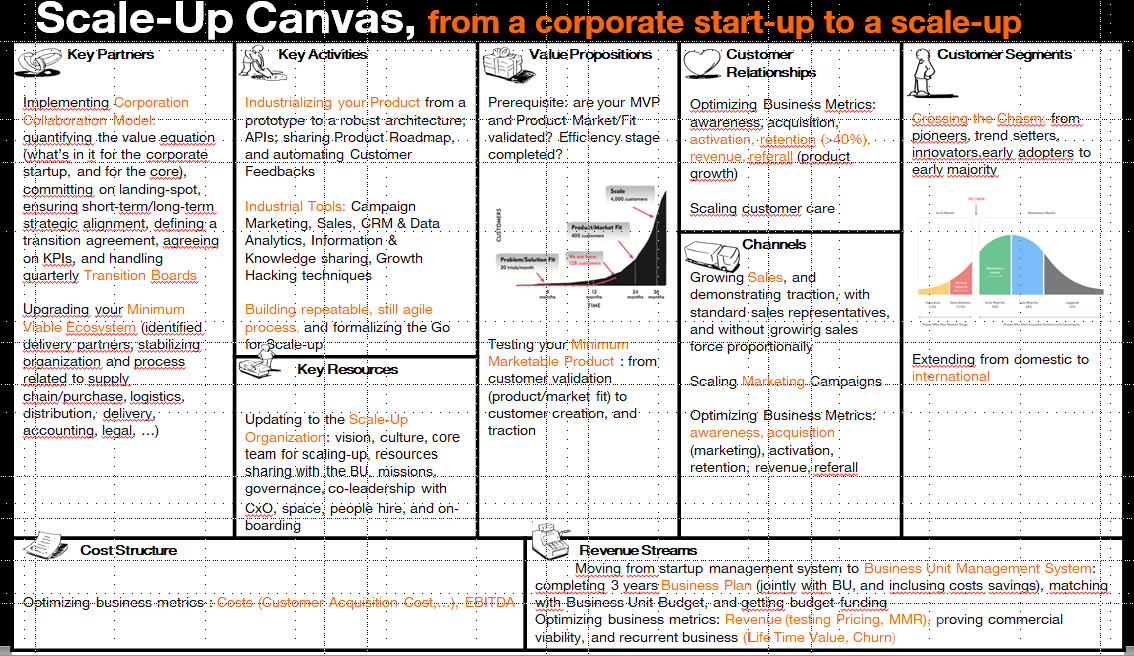While there are many supporting methodologies to start an innovation project (design thinking, lean start-up, business model canvas, blue ocean,…) or to grow a proven business, there seems to be less support for the scale-up phase.
Therefore a group of corporate innovations practitioners, representing 10 premier European companies across various industries, the Scaling-Up Peer Group, has rounded up to address the scale-up issue in a corporate environment, at the initiative and facilitated by Frank Mattes and Ralph-Christian Ohr from Innovation 3.
At Orange Intrapreneurs Studio, the time to get ready to scale corresponds roughly to the end of the incubation, and the execution of exit strategies: it might be the hand-over to a business unit, the creation of a new Orange business line, or the spin-of to a separate start-up, for examples.
The 9 squares of the Scale-Up Canvas can be sorted in 4 main thematic:
- Updating the value proposition and crossing the chasm –> corresponding to value proposition, and customers segments squares;
- Industrializing the product / service / business processes –> channels, customer relationships, activities, resources, and partners squares;
- Updating the organization for scale-up –> resources, and partners square;
- Transitioning the Start-up Management System to a Business Management System –> activities, revenues, and costs squares.
For each thematic, we have listed a list of items that the intrapreneur should have in his radar:
- Have you validated the MVP (Minimum Viable Product) and demonstrated Product / Market Fit, tweaking the product to reach stability , and gain a significant number of customers : this a pre-requisite before scaling;
- Have you designed a MMP (Minimum Marketable Product), a more advanced release of the MVP that present features, customer experience and look & feel (one also speaks of Minimum Lovable Product) that will help to move from Trend Setters and Pioneers, Innovators, and Early Adopters to Early Majority; following customer validation phase, you are now entering customer creation phase, and traction from the market: emails don’t stop coming in, and phone is ringing 24/24!
- The MMP is also when your business stream starts to get more Awareness and support from the corporation and the sponsoring business unit, and you enter a Risk-Mitigated stage;
- The intrapreneur will also question the relevance of extending his target market from domestic to international.
- Growing Sales, and demonstrating traction (incoming flow of repeat business), with standard sales representatives (meaning without the personal involvement of the intrapreneur founder), and without growing sales force proportionally;
- Scaling Marketing Campaigns;
- Scaling Customer Care : you now have more and more customers, you will have after-sales request, you need to set-up a corresponding professional service;
- Industrializing your Product development from a prototype to a robust Architecture; preparing the ground for cooperation with the corporation IT with appropriate APIs; sharing Product Roadmap, and automating Customer Feedbacks is also that needs to be industrialized;
- Implementing Industrial Tools: Campaign Marketing, Sales, CRM & Data Analytics, Information & Knowledge sharing, Growth Hacking techniques,…;
- Optimizing Business Metrics: awareness, acquisition, activation, retention, revenue, referral;
- Overall, building Repeatable, still Agile Process, and formalizing the Go for Scale-up.
- Updating to the Scale-up Organization: vision, culture, core team for scaling-up, missions, governance, co-leadership with CxO, space, people hire (based on where the core-team is expected to grow) and on-boarding;
- Upgrading your Minimum Viable Ecosystem (identified delivery partners, stabilizing organization and process related to supply chain/purchase, logistics, distribution, delivery, accounting, legal, …)
- Implementing Corporation Collaboration Model: quantifying the value equation (what’s in it for corporate startup and for the core), ensuring short-term/long-term strategic alignment, committing on landing-spot, defining a transition agreement, agreeing on KPIs, and handling quarterly Transition Boards;
- Moving from Startup Management System to Business Unit Management System: completing 3 years Business Plan (jointly completed with the sponsoring business unit, including costs savings, and making the pathway-to-profitability apparent), matching with business unit Budget, and getting budget funding;
- Optimizing Business Metrics based on automated dashboard: Revenue (testing Pricing, MMR), proving commercial viability, and recurrent business (Life Time Value, Churn), and Costs (Customer Acquisition Cost,…), EBITDA;
- Naturally this last part is particularly suited when the intrapreneur project transition to a Business Unit: when it evolves to a spin-off, the creation of a start-up external to the corporation, the collaboration has to adapt, and for example, as the start-up needs funding, you will find VCs in the loop. Also the cash burn will become an even more important issue.
As suggested by Fly The Nest, you might want to interleave an Efficiency Stage between Discovery/Validation and Scale-Up stages: the Efficiency stage is about working on the Organization to be ready to grow at fast pace: you have built a product, you need to build a business line now. In other words, it’s like a ‘soft scale-up’!
Accordingly, the check-points spotted above in Industrializing the Product / Service / Business Development and Updating the Organization for Scale-Up would then be the core of the Efficiency Stage, while the Scale-Up Stage would stress on Updating the Value Proposition, and Crossing the Chasm (with a view to grow Sales and Users exponentially), and Transitioning the Start-up Management System to a Business Management System.
The Scale-Up Canvas is here for you. Whether you are approaching the scale-up phase for your project, or you are coaching intrapreneurs, read it and share it, test it, and send me your feedbacks so that we can improve it!

15 Comments